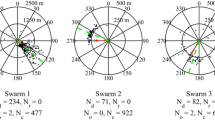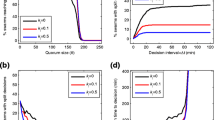Abstract
Animals that travel in groups must synchronize the timing of their departures to assure cohesion of the group. While most activities in large colonies of social insects have decentralized control, certain activities (e.g., colony migration) can have centralized control, with only a special subset of well-informed individuals making a decision that affects the entire colony. We recently discovered that a small minority of individuals in a honeybee colony—an oligarchy—decides when to trigger the departure of a swarm from its hive. The departure process begins with some bees producing the worker-piping signal (the primer for departure) and is followed by these bees producing the buzz-run signal (the releaser for departure). In this study, we determined the identity of these signalers. We found that a swarm’s nest-site scouts search for potential nest cavities prior to the departure of the swarm from its hive. Furthermore, we found that the predeparture nest-site scouts are the sole producers of the worker-piping signal and that they are the first producers of the buzz-run signal. The control of the departure of a honeybee swarm from its hive shows how a small minority of well-informed individuals in a large social insect colony can make important decisions about when a colony should take action.



Similar content being viewed by others
References
Anderson C, McShea DW (2001) Individual versus social complexity, with particular reference to ant colonies. Biol Rev 76:211–237
Boinski S, Campbell AF (1995) Use of trill vocalizations to coordinate troop movement among white-faced capuchins—a 2nd field-test. Behaviour 132:875–901
Boinski S, Garber PA (2000) On the move: how and why animals travel in groups. University of Chicago Press, Chicago, IL
Buhl J, Sumpter DJ, Couzin ID, Hale JJ, Despland E, Miller ER, Simpson SJ (2006) From disorder to order in marching locusts. Science 312:1402–1406
Camazine S, Deneubourg J-L, Franks NR, Sneyd J, Theraulaz G, Bonabeau E (2001) Self-organization in biological systems. Princeton University Press, Princeton, NJ
Combs GF (1972) The engorgement of swarming worker honeybees. J Apic Res 11:121–128
Conradt L, List C (2009) Group decisions in humans and animals: a survey. Phil Trans R Soc B 364:719–742
Conradt L, Roper TJ (2003) Group decision-making in animals. Nature 421:155–158
Conradt L, Roper TJ (2005) Consensus decision making in animals. Trends Ecol Evol 20:449–456
Conradt L, Roper TJ (2007) Democracy in animals: the evolution of shared group decisions. Proc R Soc B 274:2317–2326
Couzin ID (2006) Behavioral ecology: social organization in fission–fusion societies. Curr Biol 16:169–171
Dyer FC (2000) Group movement and individual cognition: lessons from social insects. In: Boinski S, Garber PA (eds) On the move: how and why animals travel in groups. University of Chicago Press, Chicago, IL, pp 127–164
Fell RD, Ambrose JT, Burgett M, De Jong D, Morse RA, Seeley TD (1977) The seasonal cycle of swarming in honeybees. J Apic Res 16:170–173
Forsyth A (1981) Swarming activity of polybiine social wasps (Hymenoptera: Vespidae: Polybiini). Biotropica 13:93–99
Franks NR, Pratt SC, Mallon EB, Britton NF, Sumpter DJT (2002) Information flow, opinion polling and collective intelligence in house-hunting social insects. Phil Trans R Soc B 357:1567–1583
Gilley DC (1998) The identity of nest-site scouts in honey bee swarms. Apidologie 29:229–240
Heinrich B (1981) The mechanisms and energetics of honeybee swarm temperature regulation. J Exp Biol 91:25–55
Jeanne RL (2003) Social complexity in the Hymenoptera, with special attention to the wasps. In: Kikuchi T, Azuma N, Higashi S (eds) Genes, behaviors and evolution of social insects. Hokkaido University Press, Sapporo, pp 81–130
Latty T, Duncan M, Beekman M (2009) High bee traffic disrupts transfer of directional information in flying honeybee swarms. Anim Behav 78:117–121
Lindauer M (1955) Schwarmbienen auf Wohnungssuche. Z Vgl Physiol 37:263–324
Mallon EB, Pratt SC, Franks NR (2001) Individual and aggregated decision making during nest site selection by the ant Leptothorax albipennis. Behav Ecol Sociobiol 50:352–359
Martin P (1963) Die Steuerung der Volksteilung beim Schwärmen der Bienen: zugleich ein Beitrag zum Problem der Wanderschwärme. Insect Soc 10:13–42
Pratt SC (2005) Behavioural mechanisms of collective nest-site choice by the ant Temnothorax curvispinosis. Insect Soc 52:383–392
Pratt SC, Mallon EB, Sumpter DJT, Franks NR (2002) Quorum sensing, recruitment, and collective decision-making during colony emigration by the ant Leptothorax albipennis. Behav Ecol Sociobiol 52:117–127
Prins HHT (1996) Ecology and behaviour of the African buffalo. Chapman & Hall, London, UK
Ramseyer A, Thierry B, Boissy A, Dumont B (2009) Decision-making processes in group departures of cattle. Ethology 115:948–957
Rangel J, Seeley TD (2008) The signals initiating the mass exodus of a honey bee swarm from its nest. Anim Behav 76:1943–1952
Reebs SG (2000) Can a minority of informed leaders determine the foraging movements of a fish shoal? Anim Behav 59:403–409
Rittschof CC, Seeley TD (2008) The buzz-run: how honeybees signal ‘Time to go!’. Anim Behav 75:189–197
Schultz KM, Passino KM, Seeley TD (2008) The mechanisms of flight guidance in honey bee swarms: subtle guides or streaker bees? J Exp Biol 211:3287–3295
Seeley TD (1995) The wisdom of the hive: the social physiology of honey bee colonies. Harvard University Press, Cambridge, MA
Seeley TD, Morse RA (1978) Nest site selection by the honey bee, Apis mellifera. Insect Soc 25:323–337
Seeley TD, Tautz J (2001) Worker piping in honey bee swarms and its role in preparing for liftoff. J Comp Physiol A 187:667–676
Seeley TD, Visscher PK (2003) Choosing a home: how the scouts in a honey bee swarm perceive the completion of their group decision making. Behav Ecol Sociobiol 54:511–520
Seeley TD, Visscher PK (2004) Group decision making in nest-site selection by honey bees. Apidologie 35:101–116
Seeley TD, Morse RA, Visscher PK (1979) The natural history of the flight of honey bee swarms. Psyche 86:103–113
Seeley TD, Kleinhenz M, Bujok B, Tautz J (2003) Thorough warm-up before take-off in honey bee swarms. Naturwissenschaften 90:256–260
Seeley TD, Visscher PK, Passino KM (2006) Group decision making in honey bee swarms. American Scientist 94:220–229
Simpson SJ, Sword GA, Lorch PD, Couzin ID (2006) Cannibal crickets on a forced march for protein and salt. Proc Natl Acad Sci 103:4152–4156
Sumpter DJT (2006) The principles of collective animal behaviour. Phil Trans R Soc B 361:5–22
Visscher PK (2007) Group decision making in nest-site selection among social insects. Ann Rev Entomol 52:255–275
Visscher PK, Seeley TD (2007) Coordinating a group departure: who produces the piping signals on honeybee swarms? Behav Ecol Sociobiol 61:1615–1621
von Frisch K (1967) The dance language and orientation of bees. Harvard University Press, Cambridge, MA
Wilson EO (1971) The insect societies. Harvard University Press, Cambridge, MA
Winston ML (1987) The biology of the honey bee. Harvard University Press, Cambridge, MA
Acknowledgements
We are grateful to the staff of the Shoals Marine Laboratory of Cornell University on Appledore Island, Maine. Funding was provided to JR by the US National Science Foundation Graduate Research Fellowship Program (Award number DGE 0707428), the State University of New York Graduate Underrepresented Minority Fellowship Program, and the 2008 Lewis and Clark Fund for Exploration and Field Research of the American Philosophical Society. The study was also funded by a grant to SRG from the Hunter R Rawlings III Cornell Presidential Research Scholarship.
Author information
Authors and Affiliations
Corresponding author
Additional information
Communicated by M. Beekman
Rights and permissions
About this article
Cite this article
Rangel, J., Griffin, S.R. & Seeley, T.D. An oligarchy of nest-site scouts triggers a honeybee swarm’s departure from the hive. Behav Ecol Sociobiol 64, 979–987 (2010). https://doi.org/10.1007/s00265-010-0913-4
Received:
Revised:
Accepted:
Published:
Issue Date:
DOI: https://doi.org/10.1007/s00265-010-0913-4




